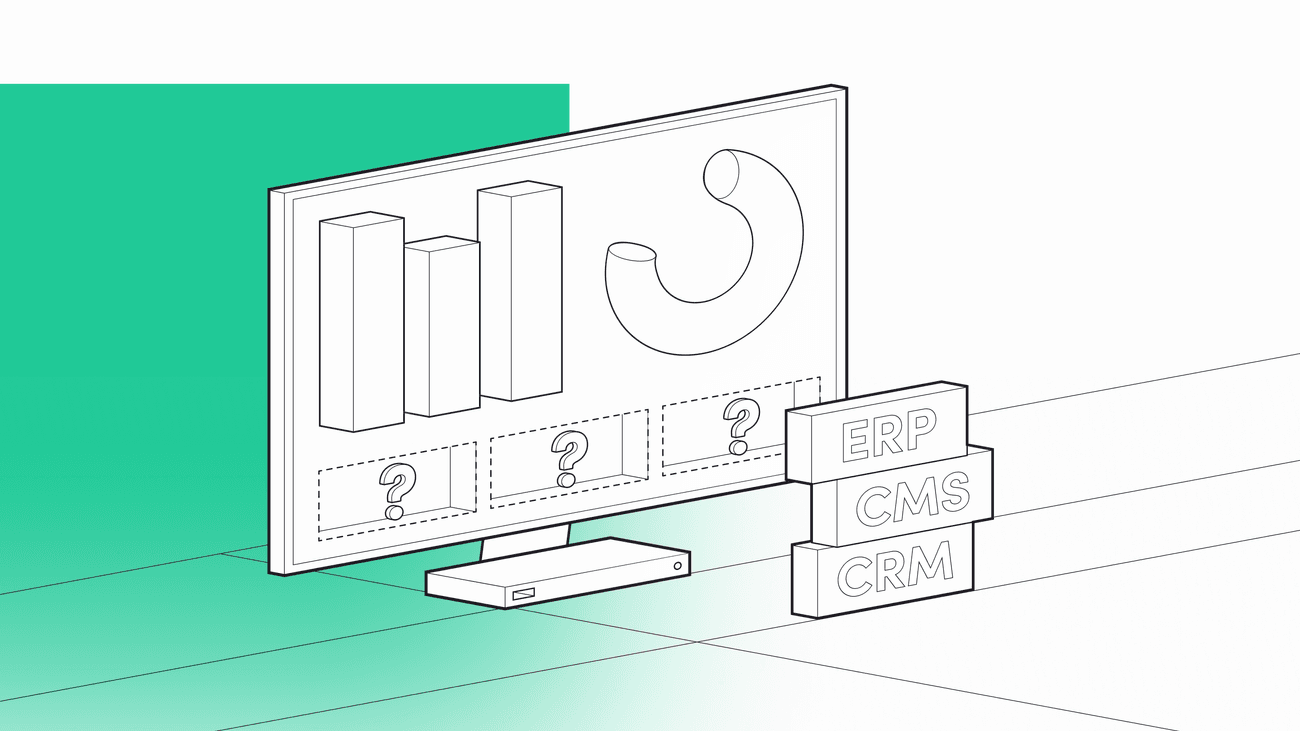Today’s world is all about innovation. No wonder then that software has become such an essential factor in business. The majority, if not all, organizations have to undergo some kind of modernization to stay on the market. Especially after 2020, we’re pushed even more towards technological solutions. Artificial intelligence, machine learning, and digitization aren’t just blunt terms but promising future solutions that already exist around us.
Content Management System (CMS), Customer Relationships Management (CRM), and Enterprise Resource Planning (ERP) are just a few of endless solutions that make your job easier. You can do it all, from automation of the business processes to project management.
Some companies implement them from the beginning, others grow first, and then – when it’s impossible to do everything manually – they decide to use technology. One way or another, that moment comes.
Which software solution is right for your business? How to pick the one that will fulfill your business needs?
In this article we discuss the differences between CRM, CMS, and ERP systems; we explain how each can help you manage and grow your business; and finally share some of our experience with developing custom versions of these tools for our clients.
What’s the difference between ERP vs CMS cs CRM?
Let’s start with the most important thing: making sense of this alphabet soup of different abbreviations. ERP, CMS, and CRM have one thing in common and that is: they help you manage your business better. But other than that, they all serve different purposes.
So how does ERP software differ from CMS and CRM systems?
Customer relationship management (CRM software)
Customer relationship management (CRM) solutions are commonly used in business-related fields, especially by teams that rely heavily on relationships and customer satisfaction (such as sales). With a CRM, you can store customer data (with information such as their contact details or demographics) in an orderly manner.
A CRM system is a great source of information about buying patterns. With it, sales and marketing teams can better target potential customers.
Content management system (CMS)
A content management system (CMS) allows you to create, manage, and publish content on your website without engaging software developers.
In short, you don’t need any technical knowledge or skills to post there or customize the design and functionalities of your website. All of this thanks to various templates and extensions available on the internet. An example of a well-known web content management system is WordPress.
On top of that, a content management system allows you to spread the knowledge about your business without spending anything, by building a website that grows with your needs.
Enterprise resource planning (ERP system)
Enterprise resource planning (ERP) software provides organizations with effective resource management and improves how your business functions – from financial data, analytics, to inventory management.
Its main goal is to facilitate business processes, especially around supply chain management. That’s why ERP systems are particularly helpful for growing businesses with multiple departments in which the flow of information may not be that strong.
An ERP system is complex and mostly serve as central data hub for each branch of the organization that deals with the resources. It automates some of the processes, which results in improved business communications, optimized cost management, and production planning.
How to get this software?
Whether you need an ERP, CMS, or CRM, there are three ways you can go about getting yourself that software.
Custom development
First of all, you can find a tech partner and create a custom solution from scratch. This way, the software will be adapted to your specific business needs and precisely meet your requirements. Not only will you have precisely what you wanted, it will also be yours forever. In our experience, this route is most often taken by medium, already growing enterprises that know what they need (and know it’s not readily available on the market) and have the resources to develop it.
Ready-made solutions
You can also buy the off-the-shelf software. Most of those solutions are sold in a software-as-a-service (SaaS) model. They can be personalized to some extent, as there may be different plans to buy, each offering a different set of features. Ready-made software is a great choice for a starting business that doesn’t have the resources to invest in custom solutions or isn’t yet sure what exactly it will need down the road.
You can read more on how custom software compares to commercial software in an article from Leo, our business development manager, who speaks on this subject in terms of e-commerce platforms.
Building your own in-house team
Lastly, you can try and do it yourself by building a development team on your own. However, this process may take a lot of time (first, you have to hire the inhouse team, and then they need to develop the software). In short, that’s probably the least beneficial option for you. However, for large enterprises that need their own solutions and know they will maintain them over a long period of time, this might prove to be the most viable solution.
Our experience with CRM and CMS solutions
At Gorrion, we had the opportunity to create many great custom digital products with our clients. Below you can read about projects our CRM and CMS projects.
SITS
For SITS, a snowboard training school, we delivered a CMS for website management and customer interactions, as well as a customer relationship management system to manage relations with schools and trainers working with SITS. The system was very extensive, it involved many different levels, such management or examination process. Our solution simplified the work of our client who could be much more efficient.
More about SITS cooperation in our portfolio.
Spin Brands
For Spin Brands, one of the best UK social media agencies, we developed a successful minimum viable product (MVP) of a CRM system for customer flow management.
For this project, we carried out a discovery workshop where we got to know the client’s business as well as users and their needs. We also did 2 usability tests and after 3 months of work, the MVP came to life.
Learn more about our cooperation from Spin Brands case study.
How we contributed to SaaS solutions
FireCloud365
FireCloud365 is one of the projects where we’re working on a SaaS solution. This cloud-based platform automates the entire fire compliance process. Thanks to the app and near-field communication (NFC) technology, app users can manage everything involved in their fire safety systems.
At first, our job was to perform a code review and fix security issues. Once we did that, we moved on to improving the platform by adding QR and NFC scanning features as well as designing an intuitive interface. As a result, the scope of our work shifted from code review to app redesign, and then to creating an entirely new app and website.
Learn more about our cooperation from FireCloud case study.
Bioledger
Bioledger is a SaaS startup that aims to facilitate biofuel compliance and create more transparent supply chains. In this project, we’ve moved from code review to rewriting the app from scratch. We transformed a simple MVP to a production-level app that’s ready for market use.
Learn more about our cooperation from Bioledger case study.
Nevaka
Nevaka is a SaaS company that provides management solution for electrical contractors. Our goal was to build a responsive web platform from the ground up.
What does this cooperation look like and what did we achieve? Read the Clutch review and get to know the perspective of Mark White, Managing Director at Nevaka.
All in all
As you can see, CRM systems, CMS, and ERP solutions are great for every growing business. They make work much more efficient and allow you to focus on other areas that can’t be automated.
As such, these systems impact business processes, project management, and resource planning. It’s a must for every modern enterprise.
This article was updated in August 2024 for comprehensiveness.


Have a project in mind?
Let’s meet - book a free consultation and we’ll get back to you within 24 hrs.
Ela writes about the fundamentals of great development, project management approaches, ways to develop a proof of concept or an MVP, UX, our company culture, and many other things happening in Gorrion.



